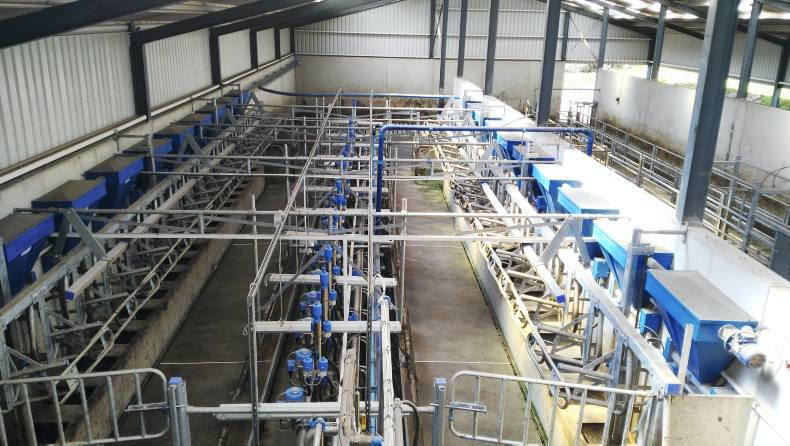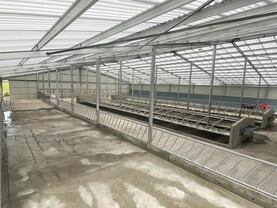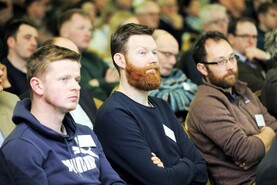With milk prices under increasing pressure, building a new parlour is not on top of the to-do list for the majority of dairy farmers at the moment. However, prices will undoubtedly turn the other way and farmers who are in the dairy expansion phase or new entrants will start to consider upgrading their setups or building a new parlour.
Most will go for lower-spec units with manual drafting systems to keep costs low and rightly so. Jimmy Cotter from Leades, Coachford, Co Cork, has been dairy farming all his life and, in January 2015, he finished building this large 20-unit parlour and drafting system for his 120 dairy herd. He was upgrading from an eight-unit herringbone parlour that was getting too old for the number of cows it was milking daily. This new parlour and drafting system is not what you would call low-spec, but it is a simple system that will allow Jimmy to carry out his work without bought-in labour.
The simple design that uses modern technology allows Jimmy to automatically draft cows for AI service after milking and the shed is also handy for the annual herd test or dosing. “With the new parlour, it only takes 45 minutes to milk all the cows which is a big difference from the old one, which could take up to 2.5 hours,” Jimmy explained.
Picture one
The shed holding the parlour, the dairy and the drafting system is seven bays (18ft) long and 57ft wide. It is approximately 14ft high at the eaves and 22ft at the apex, with a fibre cement roof. There is a covered 12ft passageway to the right of the drafting system.
Jimmy decided to cover this area because it is on a hill and he felt that too much rainwater would be flowing into the slurry tank at the end of the shed if left uncovered. Picture one shows the 20-unit Dairymaster parlour. All the stall work was hot-dipped galvanised.
There are automatic cluster removers, a dump line, milk metres and automated feeders. The digital feeder control unit allows Jimmy to feed each row at a time into the concrete trough below.
Jimmy can easily change the rate of feeding depending on the time of year, weather conditions and grass availability. All cows are teat-sprayed after milking using one of six dropdown handheld teat sprays hanging in the centre of the parlour. When a cow finishes milking, the automatic cluster removers kick in and the cluster comes away from the cow. There is no auto -luster cleaning in place, but any cows with a high cell count are drafted and milked last. Once milking is complete, the clusters are put back into their holders and the autowash is turned on to clean the milk lines before the next milking.
Pictures two and three
When cows exit the parlour, they enter a drafting system designed and supplied by O’Donovan Engineering, while the drafting unit came from Dairymaster. The outline of the drafting system is shown in Figure 1.
Usually, cows will go through the drafting race when making their exit. At breeding time, Jimmy monitors cows in the paddock and records any cow in heat on a notebook. He inputs the ID of each cow that is in heat in the parlour PC before milking starts and the autodrafting system will direct any cow that was pre-programmed in the PC to a holding pen to the left of the drafting race.
Jimmy says that the system works very well and it is rare that a pre-programmed cow will get by the drafting gate. There is also a crush area for the TB test or dosing. At the end of the crush, there is a semi-automatic head gate and headscoop for dosing cows.
An arch pole braced to the slats and held secure to two walls is the central pivot for two gates. The gates can be positioned in alternative ways, depending on the work being carried out with cows. For example, if cows were in for a herd test they would make their way from the collecting yard, through the holding yard and down to the crush entrance.
Picture four
Drafted cows are held in a slatted holding pen. There is a 12ft 6in slat on this area over a 4ft deep slurry tank. This tank feeds into an 8ft deep slurry tank at the end of the shed.
When all cows are milked, Jimmy turns his attention to inseminating these cows that are in heat. He has a self-locking barrier and uses a half barrel and some meal to encourage the cows to put their head through the barrier. Once the cow puts her head down, she is held and cannot reverse out. Jimmy artificially inseminates cows held in the barrier. Once they are all done, he opens the barrier and releases the cow back to the paddock. If just one cow is in heat, he will put her through in the crush and hold her in the head gate because she won’t have as much room to move from side to side that way.
Picture five
The collecting yard holds 120 cows over an 8ft slurry tank. Jimmy says it can be a tight fit for all the cows, but once the first row goes in it is generally not a problem. All the walls are mass concrete.
Jimmy got a grant towards the cost of the parlour through the original TAMS scheme that came to €24,000 in total. The steel used for the drafting race, the crush race and all gates came from O’Donovan Engineering and cost €11,700, including VAT.
The shed and concrete tank work was done by Tim Lyons, who is based in Macroom and it came to €98,000 including VAT. PVC doors and windows cost €2,500 including VAT. The slats were purchased from Croom Concrete and they cost €7,900, including VAT.
The 12,000-litre bulk tank and three-phase generator cost approximately €23,000 excluding VAT and the installation of three-phase electricity cost €5,800 through the ESB. Dairymaster says a 20-unit parlour of that spec costs approximately €6,500/unit (€130,000 including VAT for 20) and a drafting system costs approximately €10,000 including VAT.
The JFC power washer pump cost approximately €5,000 including VAT. Jimmy says he is happy with how the work turned out and it gives him more time to spend with his wife Ann, son Richard and daughters Miriam and Bríd, who he says are also good for helping out in the evenings and weekends.






 This is a subscriber-only article
This is a subscriber-only article















SHARING OPTIONS: